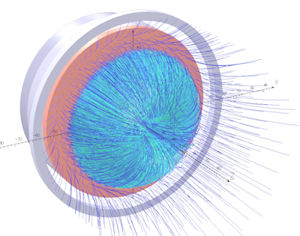June 13, 2013
 |
Cobham Technical Services - Vector Fields Software has just announced version 16 of its Opera suite for designing, simulating, and optimizing systems involving electromagnetics, electrostatics, and similar phenomena. A key new feature in this version is a solver that can simulate magnetron sputtering and thin-film coating. The developers say that this is the first time that designers of magnetrons and sputter coaters have access to an effective design simulation tool. I’ll take their word for that because while I am a known sputterer, I know little of magnetron and sputter coating methodologies. But I know more now. Back to that in a minute.
If you know Opera, go to the next paragraph. If not, here’s the 101 on Opera. It’s a general-purpose finite element system that lets you design and optimize electromagnetic devices and their wider multiphysics effects in 2D (Opera-2d) or 3D (Opera-3d) space. It’s tuned for simulation jobs with characteristics like moving parts (linear and rotational motion), sinusoidal and transient time-dependence, and non-linear materials. It can handle ion optics and thermal and stress analyses. In other words, name your nemesis: actuators, alternators, loudspeakers, magnets, micro-machines, motors, MRI scanners, particle beam devices, switches, transformers, X-ray tubes, etc. Oh, and Opera can run on your laptop or desktop workstation. And, yes, it has a 3D modeler for building and importing CAD, post-processing features, and a scripting language for you modifying mavens.
Now, Opera 16 offers what sounds like a completely re-done graphing capability (compatibility with early graphing commands is retained) and a Circuit Editor that lets you define and solve drive circuits as part of an electromagnetic solution. The values used for capacitance and inductance are calculated during an analysis and can be dependent upon other values calculated during the analysis. There are many enhancements to the software’s machines environment, including new geometric details in the definition of switched reluctance machines in the Opera-3d machines environment.
Opera-3d has been enhanced with automated (chained) multiphysics analysis. This lets you use the modeler to set up several analyses of the same model in a single database and solve them in sequence. The results of one analysis are used as the data for subsequent analyses, and data like material properties can be updated using the output of the preceding analysis. Other enhancements include the ability to automatically use the deformed mesh from a stress analysis in subsequent electromagnetic and thermal analyses in a chained multiphysics analysis dialog. Multicore parallel processing is now available for Opera-3d solvers.
Now, sputter coating is used all over the place: TVs, storage devices, computers, and so forth. Magnetron sputtering is a popular technique because it offers high sputtering efficiency and increased sputter rates at low pressure. And it has the flexibility to vary the properties of the plasma to control the characteristics of the deposited film. Simulating it, however, has been not so efficient. That’s where the new Magnetron Sputter Coater Design software introduced in Opera 16 comes in. With it, you can predict target erosion, optimize utilization, characterize the design of magnet systems, and predict deposited film profiles and deposition dynamics efficiently.
The basic idea here is that Opera 16 has a new module that can simulate the detailed physical processes involved in magnetron sputter coaters. The company reports that simulations are fast and accurate, and have been demonstrated to predict target utilization to a fraction of a percent.
The solver lets you model the interaction of plasmas in electromagnetic fields through its capacity to combine FEA with detailed models for plasma, sputtering, and thin film deposition. You can include and vary all significant physical processes in a your simulation, and its optimization abilities allow for multi-variable, multi-objective optimization. Opera supports parameterized variables, and you can specify all types of magnetrons to work with, such as circular, rectangular, balanced, or unbalanced.
Today’s Check It Out link takes you to an 8-page PDF that gives you many more technical details on Opera 16’s new Magnetron Sputter Coater Design software. The brochure is as much a tutorial on magnetron sputtering as it is a brochure on an application toolkit, which makes it a good read no matter your line of work.
Thanks, Pal. – Lockwood
Anthony J. Lockwood
Editor at Large, Desktop Engineering
Subscribe to our FREE magazine, FREE email newsletters or both!
About the Author
Anthony J. Lockwood is Digital Engineering’s founding editor. He is now retired. Contact him via [email protected].
Follow DE





